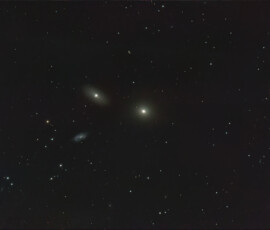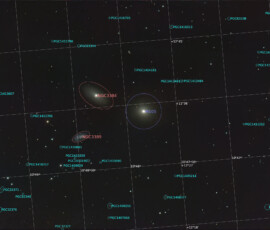Messier 105, also known as NGC 3379, is an elliptical galaxy 36.6 million light-years away in the constellation of Leo. It is the biggest elliptical galaxy in the Messier catalogue that is not in the Virgo cluster. It was discovered by Pierre Méchain in 1781, just a few days after he discovered the nearby galaxies Messier 95 and Messier 96.
It has a morphological classification of E1, indicating a standard elliptical galaxy with a flattening of 10%. The major axis is aligned along a position angle of 71°. Observation of giant stars in the halo indicate there are two general populations: a dominant metal-rich subpopulation and a weaker metal-poor group.
Messier 105 is known to have a supermassive black hole at its core whose mass is estimated to be between 1.4×108 and 2×108 M☉. The galaxy has a weak active galactic nucleus of the LINER type with a spectral class of L2/T2, meaning no broad Hα line and intermediate emission line ratios between a LINER and a H II region. The galaxy also contains a few young stars and stellar clusters, suggesting some elliptical galaxies still form new stars, but very slowly.
This galaxy, along with its companion the barred lenticular galaxy NGC 3384, is surrounded by an enormous ring of neutral hydrogen with a radius of 200 kiloparsecs (650 kilolight-years) and a mass of 1.8×109 M☉ where star formation has been detected. Messier 105 is one of several galaxies within the M96 Group (also known as the Leo I Group), a group of galaxies in the constellation Leo, the other Messier objects of which are M95 and M96. It is one of the richest group of galaxies in the Local Volume, and unlike the Local Group, it is dominated by not one but several galaxies.
NGC 3389 is an 11th magnitude spiral galaxy of morphological type Sc about 69 million light years from our solar system.

